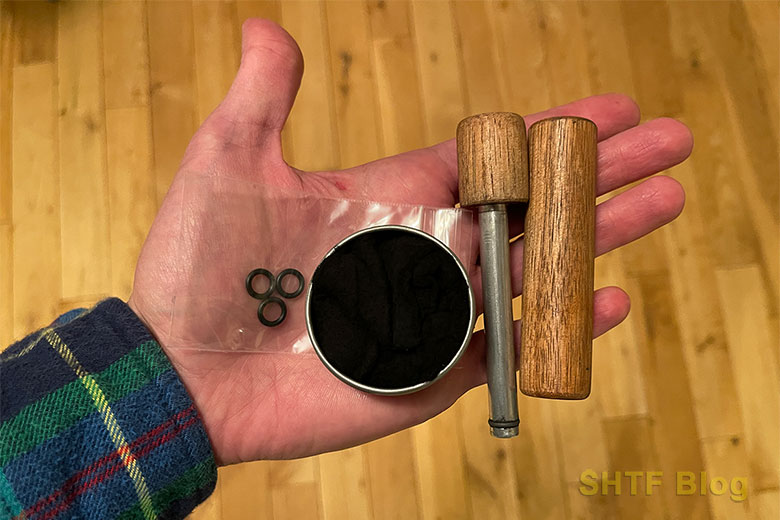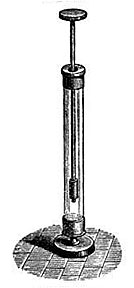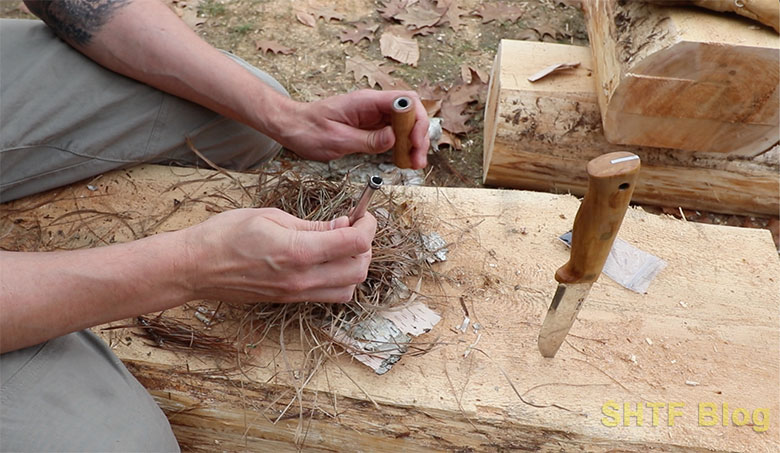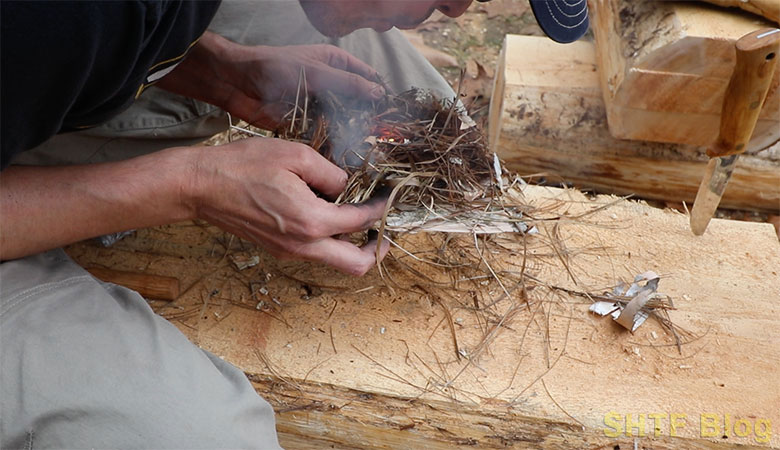
The ability to make fire is an essential survival skill, possibly the most essential skill. With fire you can make water safe to drink, cook food, generate heat, and even use it for protection. There are many ways to make a fire, and one of those method is by using fire pistons.

Sometimes called a fire syringe or a fire plunger, fire pistons have been used for hundreds of years. This process of creating fire was actually discovered independently in Europe and Southeast Asia. Abbot Agostino Ruffo discovered it by accident in 1745 when he was trying to build an air gun. When and where it was discovered in Southeast Asia is unknown.
Evidence of their use has been found in the Philippines, Thailand, Sumatra, Laos, parts of Malaysia, Myanmar, Borneo, Sumatra, and Java. The materials of construction include bone, horn, metal, bamboo, wood, and ivory.
https://www.tota.world/article/1370/
Fire pistons were a household item in England and France during the early 19th century until matches were developed.
How a Fire Piston Works
A fire piston generates a spark under the basic laws of physics. When air (gas) is rapidly compressed by a piston, the air temperature increases dramatically, creating an ignition. Kids learn this process in STEM learning as it illustrates the transfer of energy, kinetic theory, and Charles’ law. Air temperatures inside the piston can reach up to 400 degrees.
A handheld fire piston has a small piston with a tinder cavity at the end, an o-ring to seal the chamber, and cylinder to drive the piston into. The compression builds, creates heat, and ignites the tinder. This is similar to how a modern diesel engine works, and it’s why diesel engines do not require spark plugs.
How to Use a Fire Piston
I made a short YouTube video on how to use a fire piston to make a fire. Sometimes seeing something in action creates a better understanding than just reading about it.
A fire piston is simple to use. It takes a bit of trial and error to get the technique right, but give it a go and after a few rounds you’ll have it down. The biggest challenge is not with the piston itself, but making sure you have everything you need, skills included, to take the ignited tinder and transfer it to other material that you can blow into a full flame
- Lube the o-ring. The piston has to move quickly in order to rapidly compress the air and create heat. The o-ring seals out air creating, but it can’t inhibit the piston’s slide inside the cylinder. Lube just the o-ring with Vaseline, chapstick, or a bit of saliva.
- Load the tinder cavity. The heat needs something to ignite, so the right tinder is essential. Most fire pistons use char cloth. It ignites easily. You can buy it or make your own. More on that in a bit.

- Ram the piston. Drive the piston into the cylinder in one fast motion. For best results, set the device on a hard surface. Pull the piston out and you should have a hot coal in the tinder cavity.
- Blow the coal into a fire. You then pluck the tinder out of the piston and move it to your tinder pile and blow it into a flame. Having a quality pile of tinder ready to receive the coal is essential.

Are They Worth Buying?
Fire pistons are a fun, reliable way to start countless fires. I also find the coal it generates to be more forgiving than other coals created in primitive skills methods, a bow drill for example. You have more time with the coal.
Is a fire piston as effective as a lighter, match, or flamethrower? Of course not. But they make up for that in their simplicity and reliability. Fire pistons are a fully acceptable choice for a bug out bag fire starter.
5 Best Fire Pistons
All fire pistons use the same principles to create heat and flame, but their surrounding designs can vary. Here are a few of the best designs by category.
1 – Best Overall: Campfire Piston
This is the fire piston I use, and it’s the one pictured in this article and in the video I made. It has a strong, attractive hickory case with strong customer reviews. This unit comes with char cloth and spare o-rings. It’s also made in the U.S.A.
- MADE IN THE U.S.A Primary or backup fire starting tool
- Great fire starting device that uses air
The Campfire Piston is bulker than the next choice, but that isn’t necessarily a bad thing. If you are struggling to get your coal lit and have to hit the piston several times, your hand will begin to ache because you’re applying fast, direct pressure into the palm of your hand. This meatier case buffers some of that impact.
2 – Lowest Cost: SXTL Fire Piston
This fire piston is billed as an “emergency” fire starter. I agree with that description, because I would only want to use it in an actual emergency. The problem, as mentioned above, is that it’s so thin. This makes using it more challenging because you have less material to hold onto and a harder impact on your hand.
I believe this unit is made in China as it’s sold by other online retailers operating under a different name, and it looks available at wholesale prices from Alibaba.
- Compression ignition - The piston ignites the char cloth through compressed air, the same principle as the diesel engine
- Durable Design--With piston head made of copper and chamber is made of aluminum, this fire piston is built to last
However, its thin profile also makes it light and packable. Thus, it’s suitable as an emergency fire starter that can stow inside a bag or vehicle with minimal space.
3 – Fanciest: Scout-Pro
The Scout Pro is made in the U.S. by Wilderness Solution and it comes with a pressure relief valve. It’s wider size can be seen as an asset as it’s more comfortable for regular use. It also comes with a lifetime warranty.
The only downside to it is the higher cost as compared to the prior models.
4 – Most Packable: Wilderness Solution
Speaking of cost, this is the highest-cost piston I’ve listed. Also made in the U.S. by Wilderness Solutions, it comes with a lifetime warranty. Small and durable, it’s called a “firepen” because of its pen size. It can be easily stowed in a pack.
- 100% made in the USA!! Amazing survival fire starting device that uses air
- Ignites organic tinder by spontaneous combustion
The downside to this unit, beyond the cost, is its tiny size. This can make using it a real challenge. Ultimately, the user has to weigh the advantages between size and ease of use. What’s more important to you?
5 – Most Creative: Make Your Own
If you’re handy, have the right tools, and want to take your skills to the next level, you can make your own fire piston. There are various instructions online, but my favorite is the instructions from Primitive Ways. In a nutshell, it walks you through creation of a fire piston similar to the Campfire Piston that I own and use.
Materials needed are relatively simple: copper tubing, brass end cap, wooden piston, o-ring, sand paper, glue, and a few drill bits.
I would not look at making your own as a cost saving endeavor. The materials will probably cost about the same as buying a simple fire piston, not to mention your time, but some might enjoy the construction process.
How to Make Your Own Charcloth
You’ll want char cloth if you’re making a fire piston. They most effective with an easily-ignited tinder, char cloth being the most common choice. It can be bought for next to nothing, but you can also make your own quite easily.
- Take a metal can or container and poke a hole in the top with a big nail. The container must otherwise be sealed, so it needs a lid.
- Take a 100% cotton cloth (and old t-shirt works well), cut it into small pieces, and loosely toss them in the metal container.
- Set the can on a grill or other heat source (outside) and “bake” the cotton pieces inside. It will smoke and smell. When it is done smoking, the char cloth is finished.
- Let it cool and pack it with your fire piston.
Best Alternative to a Fire Piston
If you’re looking for a simple firemaking device and the fire piston isn’t what you had in mind, the best alternative is the Ferrocerium rod, or Ferro rod for short. It’s constructed of mixed metals that, when struck with a harder material, throw sparks. The scraping effect exposes the metals to oxygen and ignites them. Ferrocerium is used in many applications to generate spark for fires, including in lighters, strikers for gas welding, etc.
- 5ft Paracord included, gives you a good grip and never comes off. Comes with a bayite Striker-Pro striker attached to the paracord, always be prepared to start a fire
- bayite 6 Striking Edges Striker-Pro striker is made from TOOL GRADE HSS STEEL and has a distinct hardness, maximizes a shower of hot sparks, no matter whether you prefer to use your left hand or right hand to scrape. Don't use bad quality Knife as striker. Otherwise it will not produce enough sparks due to insufficient hardness of blade
I like my Ferro rod as much as I like fire pistons.
Which is better? I don’t know. They’re both cheap enough that you don’t have to decide, you can get both. Redundancy is good, particularly in a crisis.





